California Energy Commission Evidentiary Hearing
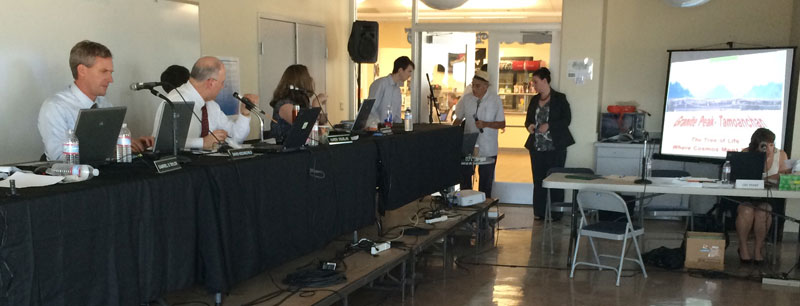
August 10, 2014 - Blythe CA - Basin & Range Watch intervened in the California Energy Commission (CEC) proceeding of this petition to amend the original Palen solar project application after BrightSource Energy bought the application from now bankrupt Solar Millennium. The current project would involve two solar power towers that would superheat water into steam to turn steam turbines in power blocks. Hundreds of thousands of mirrors (heliostats) in circles around the towers would aim sunlight onto the receiver of the tower to heat the water into steam.
The California Energy Commission held an evidentiary hearing in Blythe over two long days, July 29 and 30, 2014, where all intervenors, the petitioner BrightSource Energy, staff of the Energy Commission, and the public gathered. Intervenors include Basin & Range Watch, Center for Biological Diversity (CBD), Colorado River Indian Tribes (CRIT), and Californians for Renewable Energy (CARE) - La Cuna de Aztlan.
Economics of the "Palen Monster Tower"
One Mohave man gave a public comment that he called these the "Palen Monster Towers."
The Palen Solar Electric Generating System project is down to one 750-foot-high power tower to be built in Phase 1 but BrightSource still wants a license for two towers to build one with storage in the future. We don't think their superheated steam technology will work with molten salt storage, Solar Reserve at Crescent Dunes near Tonopah NV have a better design that may work. BrightSource's design will only add 15 minutes of operation after sunset. But they want to start up around noon and then store heat to be able to follow peak electricity usage in the late afternoon. This is all theoretical, their first proposed tower would not have storage but would have natural gas boilers to fire up when needed. The second tower would not have natural gas back-up. BrightSource said it was not economically feasible to build storage on the first phase tower.
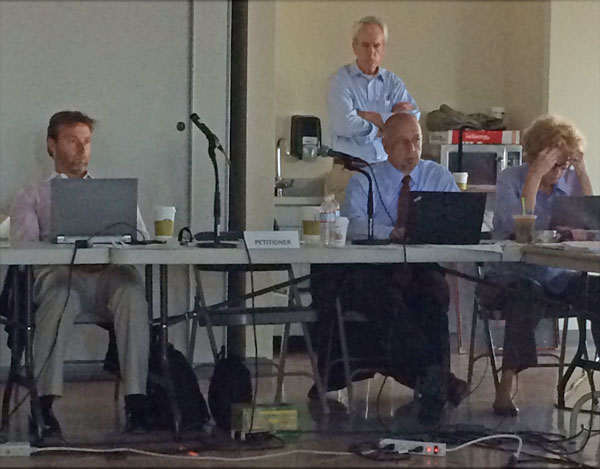
^BrightSource Energy at the hearing. It was a long hearing.
^The Crescent Dunes solar project under construction near Tonopah, Nevada, by Solar Reserve, has a single 650-foot-tall solar power tower surrounded by large mirrors. It has thermal energy storage: two molten salt tanks. BrightSource is proposing to build a similar solar power plant in two phases, one tower without storage and one with storage like this, at some undetermined future date when they can get financing. The Crescent Dunes project, however, has molten salt as the heat transfer fluid in the power tower and pipes leading to the molten salt tanks, which then transfer heat to water for the steam turbine. BrightSource's design suffers from the added heat exchange of using water as the heat transfer fluid in the power, where sunlight super-heats the water into steam, which then would connect with the molten salt tanks to transfer heat energy to the molten salt. But then the heat would have to be exchanged a second time from the molten salt tanks to water in the steam turbine -- too much heat may be lost in this complex system, compared to the simpler design of Solar Reserve's.
Engineer Bill Powers gave testimony for Center for Biological Diversity (CBD) on how rooftop solar and Distributed Generation policy has already allowed installations to outstrip expectations in California, and could easily get the megawatts necessary to move towards the 33% Renewable Portfolio Standard goal if Palen was not approved. So that is economically feasible today. In California the AB327 net metering bill passed last fall, authorizing 1900 MW of rooftop solar. Already 1800 MW has been installed, two to three years ahead of schedule. "We are far ahead in net metering," he said.
Powers said the cost of distributed generation can be brought down by bundling 20 to 40 small projects. Utility-scale photovoltaic projects currently cost less than small roof-mounted systems, but the high cost of transmission lines is not being factored in.
BrightSource said the cost of their electricity to the utilities was confidential.
Glint and Glare
Complaints about intense bright light from the mirrors at the Ivanpah solar project continue to come in from pilots, making the question of how to avoid or mitigate the light a continuing discussion with no obvious answers. One suggestion was to make the mirror reflection in standby position disrupted by projecting the heliostats in all different directions. Normally the mirrors are positioned flat and horizontal when the power plant is in standby mode and not aiming at the tower to generate electricity. But when the mirrors are in this array they create a "glare field" that projects in all directions for 360 degrees, visible in most of the airspace to aircraft.
We believe the Commissioners will have to issue an "override" on the significant impacts of this glare and glint to passing air traffic, but the question of safety to pilots remains. Not to mention hikers in the nearby mountains such as Clark Mountain at 7,933 feet elevation, within the Mojave National Preserve.
One comment by a pilot was to take an online survey of pilots on glare in Ivanpah Valley through the Airport Cooperative Research Program.

^Glare from two solar power towers reflecting sunlight from mirrors onto the receiver to superheat steam. Ivanpah Valley CA.
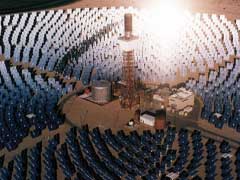
^Intense glint and glare from mirrors at the old Daggett power tower near Barstow (since dismantled).
^Photograph taken with a cell phone by a B&RW member from a commercial jet on ascent from McCarran Airport in Las Vegas, NV, looking southwest towards the Ivanpah solar project. The glare of the solar power tower flux and intense glint of mirrors in standby position is visible from quite a distance. The plane is over Lake Mead.
What The Flux?
Solar flux is defined as light energy radiated from point to point, and is different from heat energy which excites electrons. Both are expressed in watts per square meter. All objects when hot radiate electromagnetic energy in the infrared spectrum. Infrared light is not heat, but when it hits an object it is transformed into heat. This is what happens with solar flux. The air does not get hot in solar flux, but a bird passing through it will absorb the energy and become very hot.
Some actual hot air is convective from the tower receiver, however, within a few meters (less than 10 m) on the downwind side. Within 1 to 2 meters the air may be a couple of hundred degrees Celsius. The skin of the receiver can get to 600 C, according to BrightSource experts.
Expert witness for CBD Gordon Pratt, an entomologist, said the intense glowing light of the Palen solar power tower could attract large numbers of insects to their deaths like a huge bug-zapper. The insect diversity should be studied and monitored to see if any species were lost in the area over time. Malaise traps could be set up on the edges of the solar field to trap insects and monitor diversity over time. Entomologists visiting the Palen Dunes adjacent to the project site in the past found over 130 species of beetles on only four visits. Energy Commission staff said preliminary data from the Ivanpah Solar Electric Generating System power towers showed large numbers of insects being killed at times. The data did not show whether winds were blowing insects into the solar flux, or whether they were attracted by the glare of the light. Staff agreed more study was needed. David Harper, expert witness for CRIT, of the Mohave Tribe, explained how certain insects play a large role in their traditions.
CBD witness Shawn Smallwood is an expert at bird mortality at wind projects, and he testified that only two months of formal surveys have been accomplished at Ivanpah and already the numbers dwarf the avian deaths at the infamous Altamount Wind Resource Area in California’s Coast Range. A full year of surveys at Ivanpah should be carried out to better understand the bird deaths before Palen is given a license, he said. Spring month kills may be high, but sometimes August has a big kill at wind projects. California Department of Fish and Wildlife recommends a 3 year avian mortality study for wind projects now. Smallwood told us that many bats and small birds are missed in his research where he places a known number of dead bird carcasses (donated by wildlife rescue operations) out in the wind projects for his survey crew to try to locate. Even as well trained as they are, they miss most small birds, especially birds like bushtits, warblers, and sparrows. He said for every one carcass found every 7 days, multiply it by 20 for the actual estimated mortality. Scavengers eat a lot of bird and bat carcasses at wind farms, even striped skunks have been watched systematically searching for carcasses right after dark.
Bird deaths at power towers has been acute at the Ivanpah solar project due to the solar flux around the towers which burns birds flying into it. The CEC estimated that Palen could kill 3.7 times as many birds as Ivanpah.
BrightSource tried to argue that things such as cats, buildings, and transmission lines kill more birds than this project would. Part of their mitigation strategy would be to give $1,8 million to programs such as feral cat removal to reduce bird deaths. We argue that the bird species killed by urban cats is wholly different from the birds killed in a desert ecosystem. Plus, golden eagles actually prey on cats, not the other way around. Eagles could fly into the solar flux and be killed, whereas cats do not kill eagles. Smallwood told us that transmission lines kill different kinds of birds, more hawks collide with them. But beyond the difference in species, we argue that the additive mortality from all of these causes should not be an excuse to kill even more birds at the Palen project. Bird deaths everywhere should be reduced, not accumulated.
Tom Dietsch of the US Fish and Wildlife Service made a comment on how his agency was concerned with the bird mortality at Ivanpah. They are working to continue to see how to make surveys better, working with the Technical Advisory Committee. They recommended the best sort of mitigation was money spent on groups such as the Sonoran Joint Venture which seeks to work with birds local to the region.

^Model of solar flux at the proposed Palen solar project. Birds flying into this flux field would be singed or burned.

^Graph showing number of bird carcasses found singed in the project area and distance from the solar power tower and flux at the Ivanpah solar power towers.

^Bird deaths from colliding with mirrors at the Ivanpah solar project.

^Bird deaths of unknown cause at the Ivanpah solar project.

^All bird deaths total and distance from the towers at Ivanpah.

^Bird carcasses damaged by solar flux, and distance from tower at Ivanpah.
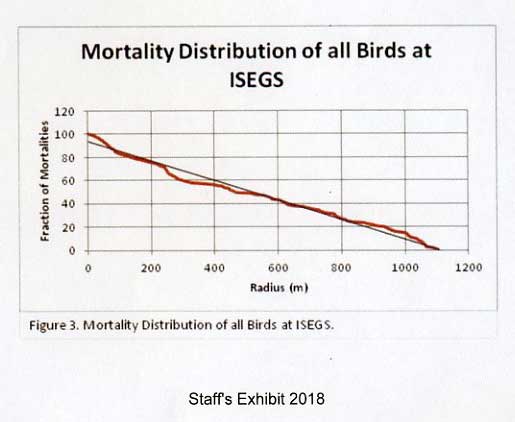
^Bird carcass distance from solar power tower at Ivanpah.
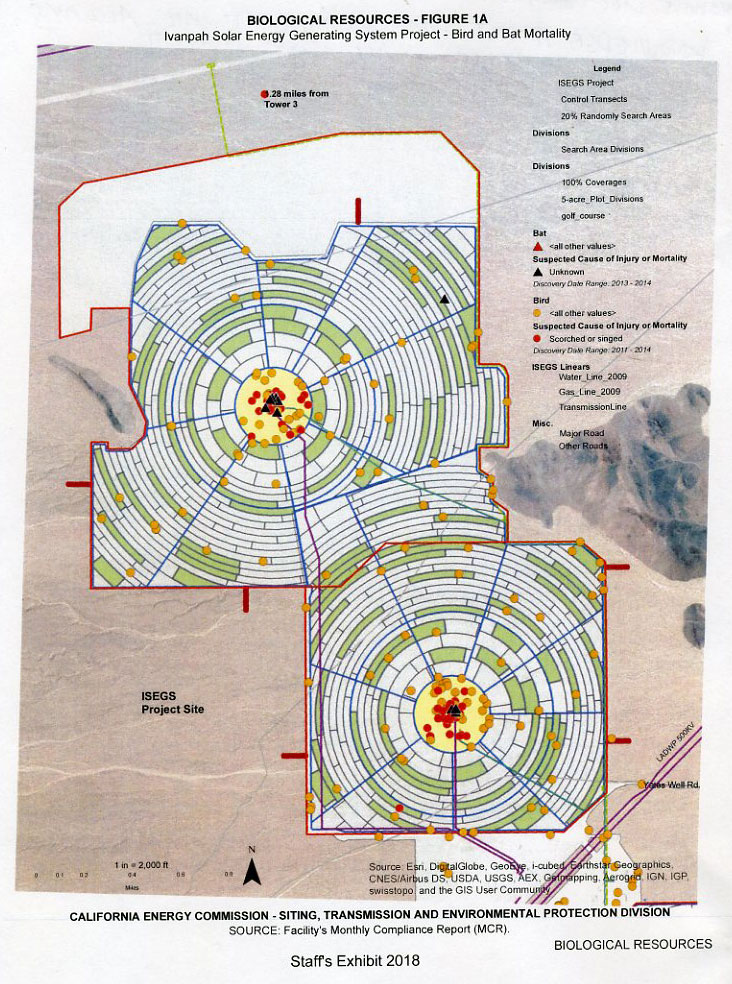
^Locations of bird and bat carcasses in the Ivanpah solar project.
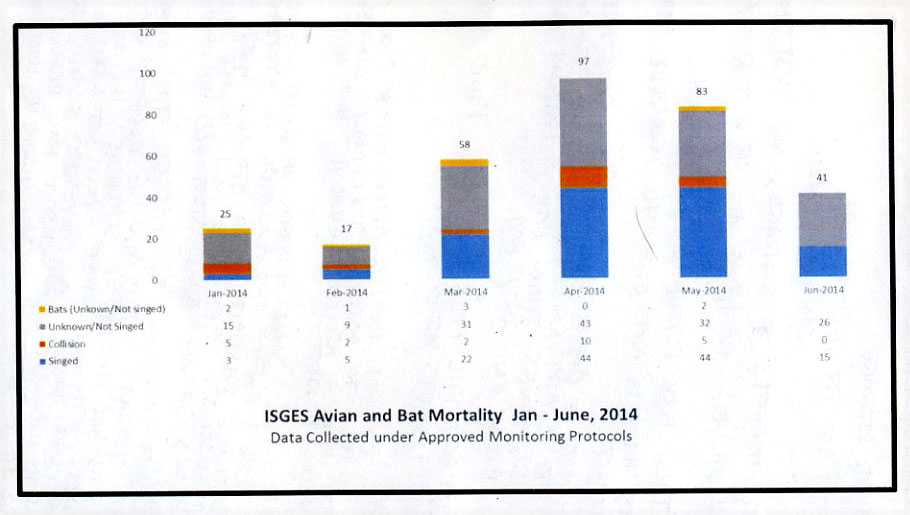
^Ivanpah solar project bird and bat mortality by month in 2014.
Cultural Concerns and Tribal Sovereignty
The tribes were there in force and dominated the hearings. We were really moved at how passionate they were -- the Mohave, Chemehuevi, Quechan, and others. They gave public comment for hours on how they opposed the project, and did a really good job of telling the Energy Commission that they must treat them as sovereign nations and accept their way of doing things. The tribes have studied the process really well and now turned it back on the commissioners. So instead of a protest, about a dozen people made long speeches during public comment, acted as expert witnesses in every topic, and the Colorado River Indian Tribes hired lawyers to officially intervene.
David Harper of the Mohave Tribe spoke eloquently as an expert witness for CRIT on cultural traditions. He said the elders asked that artifacts found on the project site should be left in the ground. They wanted to repatriate them, not have them taken and sealed up in warehouses in San Diego as happened at the Genesis Solar Energy Project nearby in Chuckwalla Valley. This caused tremendous upset among many tribal members.
Harper continued addressing the Commissioners, "I want to be cremated amongst my people, lay face down on the pyre. I will get tattooed. I will tell you, do not look it up on the Internet. You should be asking us, it is disrespectful to ask your staff and not us." he said his traditional role was as a warrior to protect his people. "Did you ask the people of the land? Why is it so hard to come and talk?"
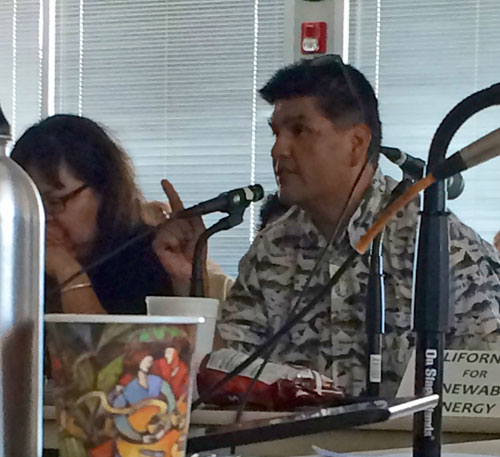
^David Harper of the Mohave Tribe gives expert testimony.

^The Energy Commission listens to tribal comments: Commissioner David Hochschild, Hearing Officer Kenneth Celli, and Commissioner Karen Douglas.
Mohave, Quechan, and Chemehuevi tribal members spoke at length during public comment about how the lack of real government-to-government consultation, and how the solar projects destroying cultural history was like the past invasion, colonialization, and now mitigation.
"We have a rich intellectual, metaphysical view of the desert," one Quechan person said.
The land is the source of law, indigenous jurisprudence, they explained. It is about relationship, connection, through dreams, songs and omens, through the generations.
A Chemehuevi person stated that "we may have lost some of the old traditions, "but we still have the land. If you do not take care of the land it will be taken away from you."
Amanda Barrera, Tribal Council Member from the Colorado River Indian Tribes, Chemehuevi Indian, made a stirring speech as public comment. She retold how she grew up in the desert in Pahrump, Nevada. She said she sees abundance in the desert -- creosote which is medicine, and yucca which provides soap. She knows how to go into the desert and what to pick for medicines. The creosote is valuable. She explained that they are an oral culture. "You speak from your heart when you are Indian, you are passing on what you are taught."
Barrera extended a formal invitation to the Commissioners and staff, as well as the petitioner, to make an appointment with their tribal council. "It will be under Tribal Law -- tribal members only can attend, or by invitation. Then you can hear our wishes." She added that no amount of money in mitigation could replace the loss of the land.
Karen Douglas, Commissioner for the CEC, responded that consultation is new for the Energy Commission. They are just now formalizing consultation policy.
Energy Commission staff said there is a real need to educate non-native Americans about the value of the desert. The ability of Native Americans to go to a certain place would be compromised if a looming tower is present, it would impact their connectedness to place.
The BrightSource attorney Scott Gallati commented that they did not want this consultation to hold up the project, "it is late in the game."
La Cuna de Aztlan Sacred Circle
Blythe resident and cultural caretaker Alfredo Figueroa gave expert testimony representing his group on the sacred landscape of the Palen region. He showed a PowerPoint exhibit to the commissioners, some of the slides are shown below. Ancient tribes traveled from the Blythe region southwards into what is now Mexico, and became the Aztec and other Nahua-speaking tribes. The Blythe area, he said, is a center of traditional teachings.
He told the Commissioners to "Seek the roots of the Truth." One must go to Blythe, go to the Colorado River to find it, it is not taught in college. The Colorado River geoglyphs are designs of Creator's travels on Earth, from Needles in California to Rocky Point in Mexico. Right now the geoglyphs are being destroyed by the Blythe and McCoy solar projects.
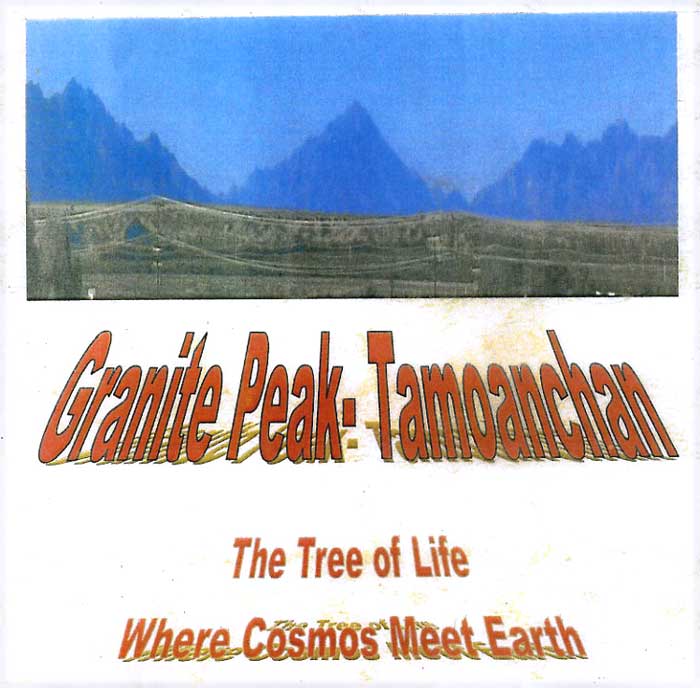
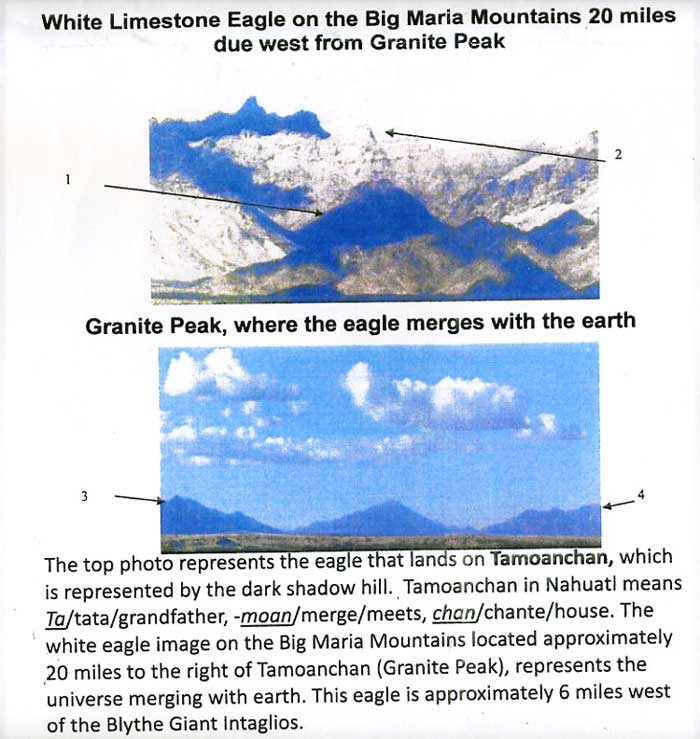

Transcripts of hearing:
